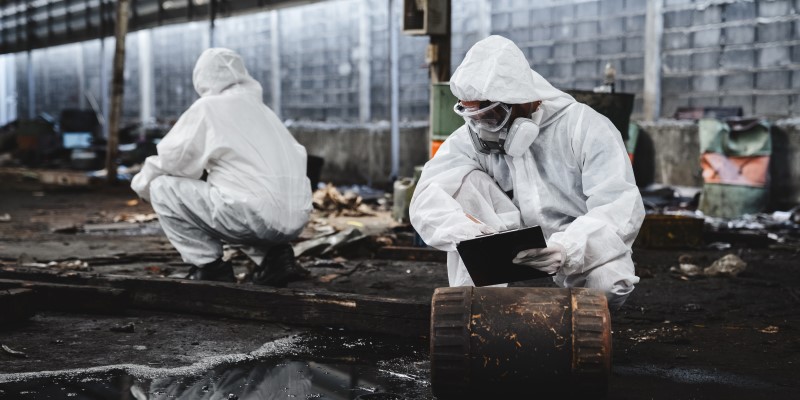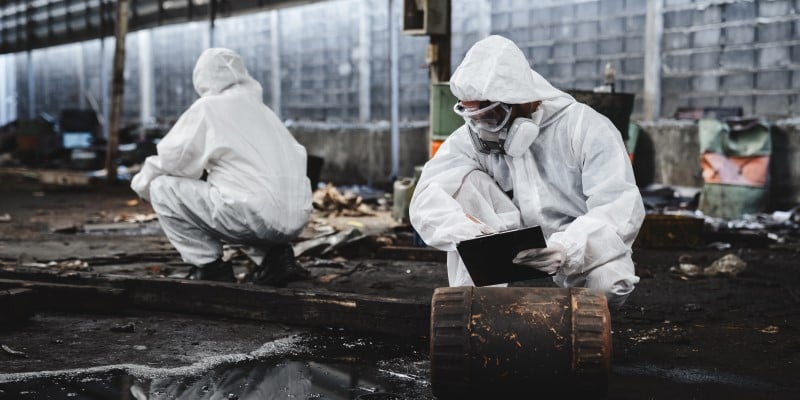
In September 1987, a small amount of Cesium-137 was removed from an abandoned cancer-therapy machine in Brazil. This petty theft resulted in hundreds of people being eventually poisoned by radiation from the substance. The incident highlighted the danger that even relatively small amounts of radiation can pose.
Origins of a Catastrophe
In September 1987, two local men entered the Instituto Goiano de Radioterapia (IGR) in the central Brazilian city of Goiânia. The private hospital had been permanently closed and partly demolished and they were looking for anything they might salvage and sell, for scrap. The IGR had moved two years earlier leaving behind an obsolete teletherapy unit in their abandoned clinic. The institute failed to inform the authorities of the existence of the outdated device and the machine had sat unattended in the building in downtown Goiania, 600 miles from Sao Paulo, until the two criminally enterprising men removed the unit in a wheelbarrow while evading a security guard in the process. What they had recovered was more than either man had bargained for.
At one time, the radiotherapy unit had served oncology patients, using ionizing radiation to control cell growth killing off remaining cancers, following the surgical removal of tumours. However, left abandoned the once life giving machine had become little more than a radiological time bomb.
Inside the teletherapy unit was a “wheel type” canister, with shielding walls of lead and steel, which was designed to rotate the radiological source material when in use, between storage and irradiation positions. Ignorant of the dangers the cannister posed, the two men prised the unit open and removed the stainless steel cannister from the heart of the machine. Inside was 3-ounces of highly radioactive caesium chloride, an inorganic salt derived from the radioisotope, scientifically known as Cesium-137 (Cs-137).
Radiation's Ripple Effect
Soon after removing the cannister, the pair experienced the dizziness and diarrhoea associated with radiation poisoning, but they attributed these symptoms to something they had eaten. One of the men quickly developed sizeable burns on his fingers, the appearance of which did not deter his partner from continuing to tinker with the cannister, finally freeing the interior capsule from its protective rotating head. Poking the capsule with a screwdriver, a dark blue light could be seen from within, mysterious and intriguing, they didn’t know this light was the florescence of electromagnetic radiation. The resulting radiation burns would cost one of the men his fingers and the other his right arm. However, the two would survive the exposure.
Unfortunately, the owner of the scrapyard and his family to whom they sold the teletherapy unit to was not so lucky.
They had passed on the unit to the scrapyard a few days after removal from the abandoned clinic, and workers there systematically dismantled the machine, in doing so releasing the Cs-137 that was still inside. Unaware of the danger they were now in and fascinated by the glowing blue stone, the workers distributed pieces of the radiant material to friends, relatives, and neighbours. The scrapyard owner tragically gave some of it to his six-year-old niece, who used the glowing blue powder as deadly dressing up decoration. It was soon after this that the deadly nature of the substance became known, when the girl’s mother realising that friends and relatives were getting sick sought medical assistance. Doctors found that they were suffering from acute radiation poisoning. Four people would eventually die from exposure, including the child. Yet scores more were hospitalized and more than 100,000 people in the city had to be monitored for contamination.
Confronting the Fallout
News of the incident would quickly spread nationwide, and the authorities would struggle with a complex clear up and decontamination operation that included 130,000 people flooding into area hospitals, afraid of exposure. Such was the attraction of the glowing blue material released from the capsule that it travelled widely, and with the help of wind and rain contamination was later found 100 miles away. One thousand individuals would be found to exhibit greater than background levels of radiation, while 249 showed significant signs of contamination. A total of 49 people had to be hospitalised; 21 required intensive medical care. The number of undetected cases was probably much higher.
Aside from the human cost, more than 40 homes in the city were found to have high levels of contamination and had to be demolished. Whole streets and squares were decontaminated, with tons of soil removed and the ground then hastily covered with concrete to seal off the remaining radiation.
Despite this effort, a study performed in 2001 still found increased activity levels 10 to 40 cm below the surface, questioning the effectiveness of the initial decontamination efforts. Even today, indeterminable amounts of Cs-137 continue to seep into groundwater supplies from the contaminated soil underneath the concrete.
There were other serious after-effects. Many citizens suffered psychologically from their fear of contamination. This fear became so widespread that following news of the widespread contamination other cities shunned the people and products of Goiânia.
Regulatory Changes and Enduring Lessons
This incident would qualify as a five out of seven on the International Scale of Nuclear Events (INES), and Brazilian national authorities would completely overhaul the regulatory framework controlling the storage of radiation sources. The public court case that followed the tragedy concluded with the three doctors who owned the IGR being ordered to pay the equivalent of $24,000 US for the derelict condition of the building. The two thieves who removed the abandoned teletherapy unit were never charged.
The Goiânia incident provides a bitter lesson about the effects of radioactive contamination in a modern metropolitan setting. More could have been learned from this disaster but follow up studies on the long-term effects of the exposed population were neglected and valuable data regarding the inadequacy of decontamination efforts was never recorded and published.
The little six-year-old girl victim of this tragedy lies buried in a lead sealed coffin isolated by concrete.






